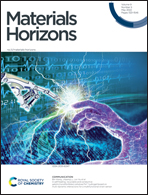Ultrasensitive airflow sensor prepared by electrostatic flocking for sound recognition and motion monitoring†
Abstract
Recently, airflow sensors have attracted great attention due to their unique characteristics. However, the preparation of high-performance airflow sensors via extraordinarily simple, controllable and cost-effective methods remains a great challenge. Herein, inspired by the fluff system of the spider, an ultrasensitive fluffy-like airflow sensor with carbon fibers (CFs) uniformly and firmly planted on the surface of a polyvinyl alcohol (PVA) fibrous substrate has been easily fabricated using electrostatic flocking technology. The fluffy-like structure endows the airflow sensor with superior properties including ultra-sensitivity, fast response time (0.103 s), low airflow velocity detection limit (0.068 m s−1), ultra-sensitive detection in a wide airflow range (0.068–16 m s−1), and multi-directional consistent response to airflow. This sensor can be used to accurately recognize sound waves and voiceless speech and detect human and object motions in different postures and speeds. This work presents insights into designing and preparing high-performance airflow sensors on a large-scale for sound recognition, motion monitoring, and assisting the disabled.



 Please wait while we load your content...
Please wait while we load your content...